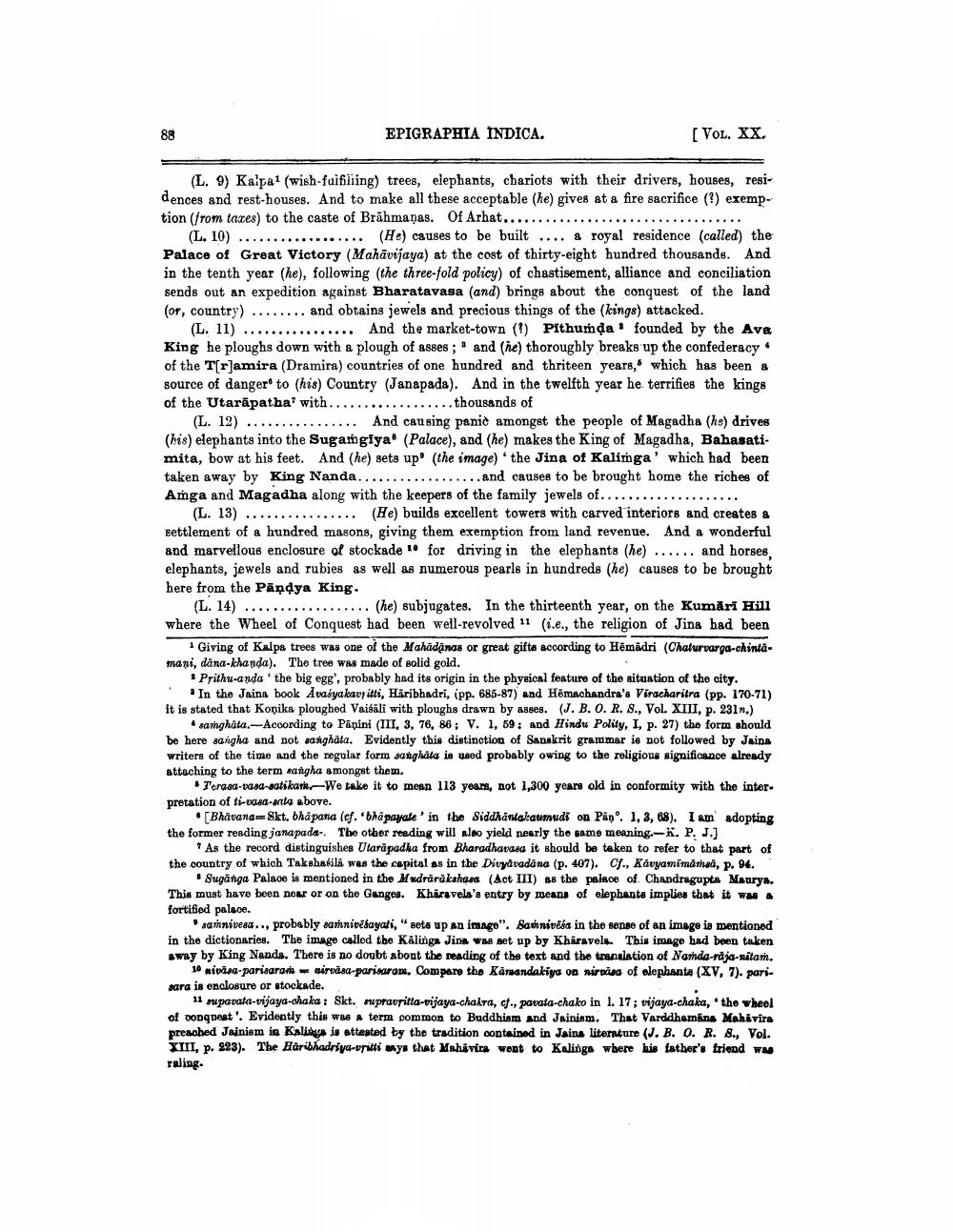________________
EPIGRAPHIA INDICA.
[Vol. XX,
.....................
(L. 9) Kalpal (wish-fuifilling) trees, elephants, chariots with their drivers, houses, residences and rest-houses. And to make all these acceptable (he) gives at a fire sacrifice (?) exemption from taxes) to the caste of Brāhmanas. Of Arhat....
(L. 10) .................. (He) causes to be built .... royal residence (called) the Palace of Great Victory (Mahāvijaya) at the cost of thirty-eight hundred thousands. And in the tenth year (he), following the three-fold policy) of chastisement, alliance and conciliation sends out an expedition against Bharatavasa (and) brings about the conquest of the land (or, country) ........ and obtains jewels and precious things of the kings) attacked.
(L. 11) ................ And the market-town (0) Pithunda! founded by the Ava King he ploughs down with a plough of asses; and (he) thorougbly breaks up the confederacy of the T[r]amira (Dramira) countries of one hundred and thriteen years, which has been a source of danger to (his) Country (Janapada). And in the twelfth year he terrifies the kings of the Utarāpatha? with.................. thousands of
(L. 12) ................ And causing panic amongst the people of Magadha (he) drives (his) elephants into the Sugamgiya (Palace), and (he) makes the King of Magadha, Bahasatimita, bow at his feet. And (he) sets up the image) the Jina of Kalimga' which had been taken away by King Nanda..................and causes to be brought home the riches of Amga and Magadha along with the keepers of the family jewels of...............
(L. 13) ................ (He) builds excellent towers with carved interiors and creates & settlement of a hundred masons, giving them exemption from land revenue. And a wonderful and marvellous enclosure of stockade !• for driving in the elephants (he) ...... and horses. elephants, jewels and rubies as well as numerous pearls in hundreds (he) causes to be brought here from the Pandya King.
(L. 14) ............ ..... (he) subjugates. In the thirteenth year, on the Kumāri Hill where the Wheel of Conquest had been well-revolved 11 (i.e., the religion of Jina had been
Giving of Kalpa trees was one of the Mahādanas or great gifts according to Hēmādri (Chaturvarga-chintamani, dana-khanda). The tree was made of solid gold.
Prithu-anda 'the big egg'. probably had its origin in the physical feature of the situation of the city.
In the Jaina book Avasya kavy itti, Haribhadri, ipp. 685-87) and Hēmachandra's Viracharitra (pp. 170-71) it is stated that Konika ploughed Vaisali with ploughs drawn by asses. (J. B.O. R. S., Vol. XIII, p. 231n.)
sanghata.--- According to Panini (III, 3, 76, 86; V. 1, 59: and Hindu Polity, I, p. 27) the form should be here sangha and not sanghäta. Evidently this distinction of Sanskrit grammar is not followed by Jaina writers of the time and the regular form sanghata is used probably owing to the religious significance already attaching to the term sangha amongst them.
Terasa-vasa-satikark---We take it to mean 113 years, not 1,300 years old in conformity with the inter. pretation of ti-vosa-anta above.
•[Bhavande Skt. bhapana (cf. 'bhapayate in the Siddhantalaumudi on Pan. 1, 3, 68). I am adopting the former reading janapada-. The other reading will also yield nearly the same meaning.- P. J.]
As the record distinguishes Utarăpadka from Bharadhatasa it should be taken to refer to that part of the country of which Takshakila was the capital as in the Divyavadana (p. 407). Cf., Kavyamimåned, p. 94.
Suganga Palace is mentioned in the Mudrāräkahusa (Act III) as the palace of Chandragupta Maurya. This must have been near or on the Ganges. Khåravela's entry by means of elephants implies that it was a fortified palace.
sannivesa.., probably sannivēšayati," sets up an image". Sau nivēša in the sense of an image is mentioned in the dictionaries. The image called the Kalinga Jina was set up by Khāravel. This image had been taken away by King Nanda. There is no doubt about the reading of the text and the translation of Narda-raja-ritam.
10 Niwisa-parisaran sirvasa-parisaran. Compare the Karuandakiya on nirwies of elephants (XV, 7). parisara is enclosure or stockade.
11 rupavata-vijaya-chaka: Skt. rupravritta-vijaya-chahta, et., pavala-chako in 1. 17; vijaya-chaka, 'the wheel of conquest'. Evidently this was a term pommon to Buddhism and Jainism. That Varddhamana Mahavira preached Jainism in Kaliais attested by the tradition contained in Jaina literature (J. B. 0. R. 8., Vol. XIII, p. 223). The Haribhadriya-vritti mys that Mahavira wont to Kalings where his father's friend ww raling.




